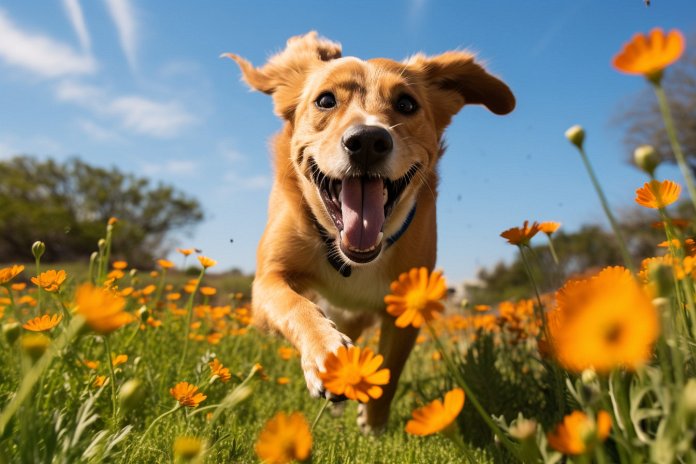
We often see dogs in YouTube videos running around with high energy levels. While some dogs may have more energy than others, is it possible for a dog to be truly hyperactive?
Hyperactivity in Dogs
Hyperactivity in dogs is actually quite rare. In most cases, dogs that seem overactive are actually lacking some form of stimulation in their lives, whether it be physical, mental, or social stimulation. Certain dog breeds are naturally more active and require more stimuli to stay happy.
Signs of Hyperactivity in Dogs
Distinguishing between hyperactivity and extreme boredom can be challenging. Some signs that may indicate hyperactivity include an inability to relax even in familiar environments, reacting excessively to routine stimuli, having a short attention span, and having elevated heart and respiration rates. Overactive dogs may seem to have endless energy, but they won’t display the same symptoms as hyperactive dogs.
Other common symptoms of hyperactivity include compulsive movements like spinning in circles and chasing their own tail. Hyperactive dogs are often restless, constantly moving and panting. If you notice frantic and abnormal behavior in your dog, they could be dealing with hyperactivity. Hyperactive dogs also have difficulty focusing their eyes on one specific thing.
Body Language
The body language of a hyperactive dog can reveal a lot about what they’re experiencing. Their pacing, running, and other frantic movements can provide insight into their current state. Hyperactive dogs feel that they’re not getting enough stimulation throughout the day, and their hyperactivity is a response to this lack of stimulation.
Here are a few signs you may notice if your dog is hyperactive:
– Panting
– Jumping Up
– Pacing
Other Signs
These are other signs you may notice if your dog is hyperactive:
– Inability to be completely relaxed in familiar environments
– Short attention span
– Elevated baseline heart and respiration rates
– Frantic, abnormal behavior such as spinning in circles
– Inability to focus eyes
Science Behind Dogs Being Hyperactive
While hyperactivity is rare in dogs, it is becoming more common, and scientists are still trying to understand why. Veterinarians often refer to hyperactive dogs as hyperkinetic. These dogs never seem to get used to regular smells, sights, and sounds, which causes them to be unable to rest even in seemingly peaceful situations.
To be diagnosed as hyperactive or hyperkinetic, dogs generally need to be at least three years old. This is because hyperactivity in younger dogs may be due to their age. Dogs that are still overactive past this point and also experience poor body condition, increased heart and respiratory rates, agitation, and reactivity are likely to be hyperactive.
Certain dogs are more prone to being overactive. Working or sporting dog breeds, for example, require more physical and mental activity on a daily basis compared to less active breeds. If you have a dog that seems to need more activity, try taking them on long walks or engaging in activities like fetch or tug-of-war.
Training classes can also be beneficial for dogs with a lot of energy. Consider enrolling your dog in basic training classes or agility training. If you’re still struggling with hyperactivity, it may be time to consult a veterinarian.
Training a Hyperactive Dog
If you believe your dog is hyperactive, schedule a visit with your veterinarian. If your vet confirms the issue, they may refer you to an animal behavior specialist.
Before meeting with the behavior specialist, start documenting your dog’s behaviors and when they occur. Take note of the time and any triggers for the unwanted behavior. You may notice patterns, such as barking and running when the kitchen timer goes off or yelping when children run through the house.
During your meeting with the behaviorist, you may need to discuss the amount of physical and mental activity your dog receives each day. This includes exercise, playtime, exploration time, and social interaction.
The behaviorist will also want to know how you have been reacting to your dog’s behaviors, as sometimes what may appear as hyperactivity is actually a learned behavior based on your reactions.
“Hyperactivity in dogs is a reaction to a perceived lack of stimulation. It’s characterized by continual movement, reactivity to routine stimuli, short attention span, and elevated heart and respiration rates. It’s important to distinguish hyperactivity from high energy; the former is a medical condition that requires professional intervention.”

Tips & Things to Know
1️⃣ Hyperactivity in dogs is rare, but possible. Common signs include the inability to relax even in familiar environments, reactivity to routine stimuli, short attention span, and elevated baseline heart and respiration rates. Other symptoms may include compulsive movements like spinning in circles, restlessness, and difficulty focusing their eyes on one thing.
2️⃣ If you suspect your dog is hyperactive, it’s advisable to schedule a visit with your veterinarian. If your vet agrees that there is a problem, they may refer you to an animal behavior specialist who can provide further assistance. Prior to your visit, start documenting your dog’s behaviors and when they occur to help identify any triggers or patterns.
3️⃣ Increasing physical and mental activity can help manage a dog’s hyperactivity. This may involve long walks, playing games like fetch or tug-of-war, or enrolling your dog in training or agility classes. A vet can also provide advice on appropriate diet and exercise, and help identify any underlying health issues that could be causing the hyperactive behavior.
Frequently Asked Questions, Answered ✅
1. Can a dog truly be hyperactive?
– Yes, although it is rare, hyperactivity is a possibility in dogs.
2. How can you tell if your dog is truly hyperactive?
– Some signs of hyperactivity in dogs include the inability to relax even in familiar environments, reactivity to routine stimuli, short attention span, and elevated baseline heart and respiration rates.
3. What are some other symptoms of hyperactivity in dogs?
– Other symptoms can include compulsive movements like spinning in circles, chasing their own tail, restlessness, constant movement and panting, and an inability to focus their eyes on any one thing.
4. What causes hyperactivity in dogs?
– Hyperactivity in dogs is often caused by a lack of stimulation in their lives, whether it be physical, mental, or social stimuli. Certain dog breeds are also more active than others and require more stimuli to stay happy.
5. How can you deal with a hyperactive dog?
– Taking your dog on long walks, playing fetch or tug-of-war, enrolling them in training classes, and consulting with a veterinarian or animal behavior specialist can all help in managing and training a hyperactive dog.